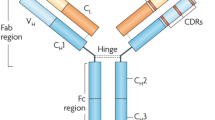Abstract
Purpose of the Review
This article provides a concise overview of important aspects of immunology related to atopic disorders and the key inflammatory components that biologic agents target.
Recent Findings
Over 15 years ago, the first biologic agent for an allergic disease gained FDA approval. Since then, additional attention has been given to elucidating the underlying pathways involved in these inflammatory disorders and identifying other potential targets that may be used to treat these conditions. In the last 5 years, not only have new biologic agents emerged to treat other atopic conditions, but also currently available agents have gained additional indications and even more unique biologic agents are in the research pipeline, currently undergoing Phase 2 and 3 trials. These agents provide the potential therapeutic option to treat multiple disorders with a single intervention and thus a familiarity with the immunology of allergic diseases as well as the aspects of the immune system that each biologic agent targets can aid the practitioner in selection of which agent to utilize.
Summary
The potential to select a biologic agent that targets a particularly inflammatory element and allows the practitioner to provide treatment for more than one atopic disorder is a very exciting prospect, indeed. Knowledge of the inflammatory cascade and, in particular, type 2 inflammation can assist in the selection of which agent or agents to consider using when treating these allergic diseases.

Similar content being viewed by others
References
Papers of particular interest, published recently, have been highlighted as: • Of importance •• Of major importance
Shamji MH, Durham SR. Mechanisms of allergen immunotherapy for inhaled allergens and predictive biomarkers. J Allergy Clin Immunol. 2017;140:1485–98.
• Gandhi NA, Bennett BL, NMH G, et al. Targeting key proximal drivers of type 2 inflammation in disease. Nat Rev Drug Discov. 2016;15(1):35–40. This manuscript reviews the key drivers of type 2 inflammation in atopic disorders.
•• Stevens WW, Peters AT, Tan BK, et al. Associations between inflammatory endotypes and clinical presentations in Chronic Rhinosinusitis. J Allergy Clin Immunol Pract. 2019;7:2812. https://doi.org/10.1016/j.jaip.2019.05.009This study evaluates biomarkers seen in chronic rhinosinusitis with nasal polyposis and demonstrates biomarkers significant for type 2 inflammation found in polyp tissue.
Smith KA, Pulsipher A, Gabrielsen DA, et al. Biologics in chronic rhinosinusitis: an update and thoughts for future directions. Amer J of Rhinol Allergy. 2018;32(5):412–23.
Jeong CW, Ahn KS, Rho NK, Park YD, Lee DY, Lee JH, et al. Differential in vivo cytokine mRNA expression in lesional skin of intrinsic vs. extrinsic atopic dermatitis patients using semiquantitative RT-PCR. Clin Exp Allergy. 2003;33(12):1717–24.
Kay AB. Allergy and allergic diseases. First of two parts. N Engl J Med. 2001;344(1):30–7.
Kay AB. Allergy and allergic diseases. Second of two parts. N Engl J Med. 2001;344(1):109–13.
Wynn TA. Type 2 cytokines: mechanisms and therapeutic strategies. Nat Rev Immunol. 2015;15(5):271–82.
Fort MM, Cheung J, Yen D, Li J, Zurawski SM, Lo S, et al. IL-25 induces IL-4, IL-5, and IL-13 and Th2 associated pathologies in vivo. Immunity. 2001;15(6):985–95.
Schmitz J, Owyang A, Oldham E, Song Y, Murphy E, McClanahan T, et al. IL-33, an interluekin-1-like cytokine that signals via the IL-1 receptor-related protein ST2 and induces T helper type 2-associated cytokines. Immunity. 2005;23(5):479–90.
Lui YJ, Soumelis V, Watanabe N, et al. TSLP: an epithelial cell cytokine that regulates T cell differentiation by conditioning dendritic cell maturation. Annu Rev Immunol. 2007;25:193–219.
Dupilumab package insert. https://www.accessdata.fda.gov/drugsatfda_docs/label/2017/761055lbl.pdf, accessed August 30, 2019.
Mepolizumab package insert. https://gsksource.com/pharma/content/dam/GlaxoSmithKline/US/en/Prescribing_Information/Nucala/pdf/NUCALA-PI-PIL-IFU-COMBINED.PDF. Accessed August 30, 2019.
Reslizumab package insert. https://www.cinqair.com/globalassets/cinqair/prescribinginformation.pdf. Accessed August 30, 2019.
Benralizumab package insert. https://www.azpicentral.com/fasenra/fasenra.pdf#page=1. Accessed August 30, 2019.
Benralizumab receives orphan drug status for eosinophilic esophagitis. https://www.empr.com/home/news/drugs-in-the-pipeline/benralizumab-receives-orphan-drug-status-for-eosinophilic-esophagitis/. Accessed September 23, 2019.
Franzese CB. The basics of immunology. In: Franzese CB, Damask CC, Wise SK, Ryan MW, editors. Handbook of otolaryngic allergy. New York: Thieme; 2019.
• Damask CC. Biologics. In: Franzese CB, Damask CC, Wise SK, Ryan MW, editors. Handbook of otolaryngic allergy. New York: Thieme; 2019. This book chapter provides a concise summary of current biologics indicated for atopic disorders and some future ones.
Johansson SGO, Haahtela T, O’Byrne M. Omalizumab and the immune system: an overview of preclinical and clinical data. Ann Allergy Asthma Immunol. 2002;89:132–8.
Omalizumab package insert. https://www.gene.com/download/pdf/xolair_prescribing.pdf. Accessed August 30, 2019.
Maurer M, Gimenez-Arnau AM, Sussman G, et al. Ligelizumab for chronic spontaneous urticaria. N Engl J Med. 2019;381:1321–32.
Author information
Authors and Affiliations
Corresponding author
Ethics declarations
Conflict of Interest
Christine Franzese reports research support from Merck; honorarium from speakers bureau and research support from GSK; honorarium from speakers bureau and research support from ALK; research support from Novartis; research support from Genetech/Roche; personal fees and research support from AstraZeneca; honorarium from speakers bureau from Sanofi/Regeneron; and honorarium from speakers bureau and research support from Optinose.
Human and Animal Rights and Informed Consent
This article does not contain any studies with human or animal subjects performed by any of the authors.
Additional information
Publisher’s Note
Springer Nature remains neutral with regard to jurisdictional claims in published maps and institutional affiliations.
This article is part of the Topical Collection on Otolaryngic Allergy
Rights and permissions
About this article
Cite this article
Franzese, C. Brief Immunology Review for Targeted Biologic Therapies in Allergic Disease. Curr Otorhinolaryngol Rep 8, 14–18 (2020). https://doi.org/10.1007/s40136-020-00263-0
Published:
Issue Date:
DOI: https://doi.org/10.1007/s40136-020-00263-0




